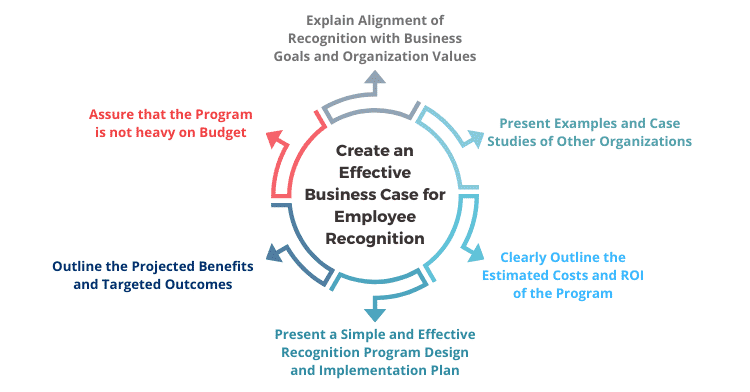1. HR teams must build a compelling business case by citing critical research data and aligning the program with business goals and organizational values to secure approval for an employee recognition program.
2. Emphasize that the program does not need to be expensive, focusing on timely and frequent recognition rather than high-cost rewards.
3. Clearly outline the projected benefits, estimated costs, and ROI, demonstrating how the program can enhance employee engagement, retention, and overall business success.
4. Present case studies from other organizations to provide real-world examples of successful programs and their positive impact on business outcomes.
The impact of employee recognition is well known. Despite this, every organization looking to set up such a program must justify the investment internally. Hence, the HR team must create a compelling business case for employee recognition to get the necessary funding and other approvals.
Also read: Common Misconceptions about Employee Recognition Platforms

First, the HR Team should quote critical research data to justify the investment to the management.
The following data on employee recognition from research studies can prove helpful:
According to the findings of a survey, 69% of the participating employees accepted that being rewarded and recognized motivated them to continue with their current employer.

28% of employees have acknowledged the recognition from their immediate superiors as the most powerful form of recognition.

The results of research by Gartner have revealed that positive peer feedback can help in enhancing employee performance by 14%.

Another study has shown that frequent recognition boosts retention considerably as 63% of employees surveyed said that they were not likely to seek another job option within the next 3-6 months due to receiving frequent recognition.

Overall, the lack of a proper employee rewards program is one of the primary reasons for the decrease in employee engagement levels.
Disengaged employees can impact the company financially.
The HR team needs to build a solid business case for employee recognition by presenting verifiable facts.
1. Explain Alignment of Recognition with Business Goals and Organization Values
2. Assure that the Program is Not Heavy on Budget
3. Outline the Projected Benefits and Targeted Outcomes
4. Present a Simple and Effective Recognition Program Design and Implementation Plan
5. Clearly Outline the Estimated Costs and ROI of the Program
6. Present Examples and Case Studies of Other Organizations


Every organization sets some short and long-term goals for its employees to achieve.
These might include increasing brand awareness, reaching specific business milestones, or establishing stronger customer relationships.
Hence, aligning these goals with the recognition program makes employees feel connected with the success of the business and motivates them to drive outstanding business results.
Aligning recognition with organizational values also helps build the desired work culture, which can provide long-term benefits.

Most organizations oppose implementing an employee recognition program because they believe it would be too expensive.
The HR teams need to emphasize the importance of providing timely and frequent recognition rather than it being of high monetary value.
A simple thank you note for a task well done or providing an extra day off to employees for a job well done can be highly effective ways of recognizing employees.

The team should highlight the projected benefits and targeted outcomes of making employee recognition an integral part of HR strategy.
The focus should be on how the program will impact the business and how it is likely to enhance employee engagement and commitment toward the organization.
Overall, the significant role of such programs in boosting talent retention rates and building a strong employer brand to attract great talent from the market should also be emphasized.

HR teams should thoroughly research the needs of the business and the workforce.
They should present a simple and effective program design and implementation plan to their management.
Employee recognition platforms are available in the market that can make implementing employee recognition programs extremely simple, cost-effective, and result-oriented.
Hence, the features and functionalities of these platforms should be carefully assessed and compared to match the program’s needs and ensure smooth integration with existing systems.

Importantly, presenting an estimate of overall costs and expected returns is essential to build a strong business case.
So, management can use this information to understand the program’s financial benefits and long-term impact.

Additionally, HR Teams should also try to present case studies of other organizations that have benefited from such programs.
Case studies of industry peers would have an added advantage.
Moreover, they could also share case studies of failed programs and lessons learned to provide a balanced perspective.
Building an effective business case for employee recognition by clearly articulating its benefits is a critical step for HR teams to secure approval from their management to implement employee recognition programs in their organizations.

Lead author: Sagar Chaudhuri, the Co-Founder and CEO of HiFives. He is an HR Tech Evangelist with over 25 years of corporate and entrepreneurship experience. In the past, Sagar has worked in leadership roles with companies such as Genpact, Infosys, and ICICI Bank. He has an engineering degree from IIT Kharagpur and an MBA from IIM Lucknow. Connect on LinkedIn
To stay updated on the latest HiFives blogs, follow us on Twitter (@MyHiFives)